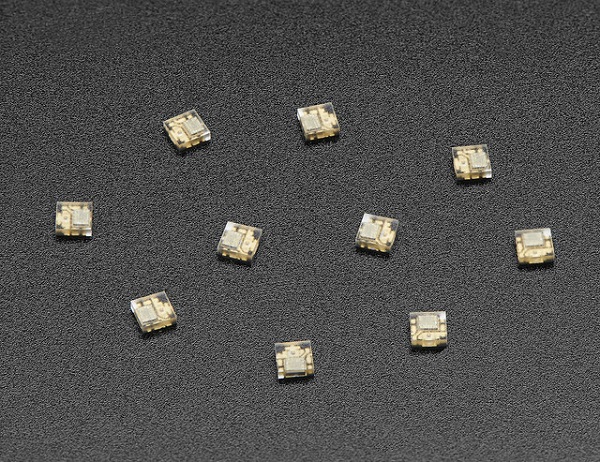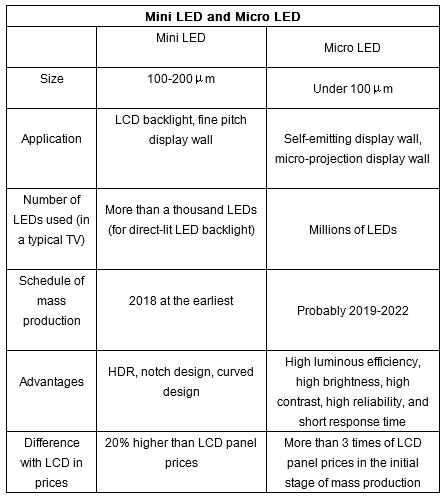As a popular product in the LED display industry, Micro LED is regarded as a leader of next-generation display technology. A large number of manufacturers at home and abroad have paid attention to Micro LED, which has promising market prospects.
According to LEDinside's latest report, revenue of the Micro LED market is estimated to reach 2.891 billion US dollars.
Despite the promising outlook, Micro LED is still faced with a huge number of technical bottlenecks. Breakthroughs have not been made in terms of some key technologies and equipment. In this situation, LED companies have turned to develop Mini LED, a relatively mature transitional technology.
 |
|
(Image: Micro LED Adafruit Industries via Flickr CC2.0) |
Since the concepts of Micro LED and Mini LED are widely discussed, what are they? What is the difference between the two? To make it clear, LEDinside has provided the following details for readers.
What is the difference between Mini LED and Micro LED?
Theoretically speaking, Mini LED and Micro LED stand for two different things. Micro LED is a new-generation display technology, a miniaturized LED with matrix. In simple terms, the LED backlight is thinner, miniaturized, and arrayed, with the LED unit smaller than 100 micrometers. Each pixel is individually addressed and driven to emit light (self-emitting), just like OLED.
The Mini LED, also known as "sub-millimeter light emitting diode," was first proposed by Epistar to refer to LEDs with a size of about 100 micrometer. Mini LED is a transitional technology between traditional LED and Micro LED, and is an improved version of traditional LED backlight.
Micro LED has a simpler structure with better performance, but the biggest problem is the mass transfer. The challenge is how to miniaturize the LEDs, which requires wafer-level technology. For example, 4K Micro LED screens require more than 24.88 million LED chips.
In terms of manufacturing process Mini LED has higher yield rate compared with Micro LED. Mini LED is also suitable for notch design and highly curved backlight when coupling with flexible substrates. The feature of local dimming also help Mini LED products have better color rendering performance. For LCD panels, Mini LED technology enables more categories of HDR, and Mini LED products can be as thin as OLED ones, saving power as well.
Due to the difference in chip size, Micro LED and Mini LED are applied to different areas.
General LED chips are mainly used for lighting and backlight modules in displays; while Mini LEDs are used for backlight applications in power-saving, thinner, HDR, and notch design displays, for example, displays of smartphones, TVs, automotive displays, and gaming notebooks. As for Micro LED, its application is completely different from the previous two. As an entirely new display technology, Micro LED can be applied to wearable handsets, smartphones, automotive displays, augmented reality/virtual reality products, displays wall and television, etc.
Micro LED has inherited the advantages of inorganic LEDs such as high efficiency, high brightness, high reliability, and short response. On the other hand, Micro LED has the characteristics of self-emitting (without backlight), which makes it smaller in size, light, thin, and energy saving.
In terms of mass production, it is easier for Mini LED technology, which is less difficult than Micro LED, to achieve mass production. Most of the existing equipment can be used for mass production of Mini LED. In addition, Mini LED is more economical due to its potential in LCD display backlight market.
According to the cost estimate, cost of a LCD panel with Mini LED backlight is about only 70-80% of that of OLED TV panel, but the performances in contrast are similar. At the same time, a 65-inch LCD panel with Mini LED backlight uses 18,000 to 20,000 LEDs, which will largely consume the production capacity of LED chip makers.
In general, Micro LED, a revolutionary next-generation display technology, will make significant improvements for the image quality, but the current technology is not mature yet. Mini LED is an improved version of LED backlight, but it can still significantly increase the image quality of LCD displays. Moreover, it is easier to control the cost of Mini LED, which is more likely to be the mainstream of market.
Mini LED market is promising in the next two or three years, Micro LED will become a superstar in the future
According to LEDinside, many LED companies have been investing in Mini LED technology, such as upstream wafer factories like Epistar, Lextar, San’an Optoelectronics, HC SemiTek, etc., packaging companies like Everlight, Advanced Optoelectronic Technology, Harvatek, etc., IC designers like Macroblock, Raydium, Jasper Display, etc., panel makers like AU Optronics, and Innolux, and digital display makers like Leyard, etc.
The companies have also covered Mini LED. AU Optronics and Innolux, two major panel makers in Taiwan, will launch related Mini LED backlight products this year. Additionally, a number of companies in mainland China also announced to enter mass production of Mini LED products.
For example, Refond stated that it is cooperating with world renowned telecommunication companies in the development of Mini LED backlight modules for smartphones and flexible curved Mini LED packaging, and has already entered small volume production; Shenzhen MTC Optronics Co., Ltd (BMTC) is currently developing Micro LED technology including wafers, packages, and mass transfer technology. At the same time, it focuses on Mini LED development by cooperating with well-known smartphone manufacturers in China, and has entered mass production. It can be seen that in the next two to three years, the Mini LED market will have opportunity to expand.
Mini LED is a transitional product, so it is still difficult to predict the development cycle of it. It will mainly depend on whether the industry can break through the technical bottlenecks of Micro LED. Before the mass transfer technology mature, there is still a far way for products and applications of Micro LED go commercial. However, the breakthrough of Micro LED technology is just around the corner as major manufacturers and startups have emerged to devote to this field one after another.
 |
|
(Source: LEDinside) |






 CN
TW
EN
CN
TW
EN







